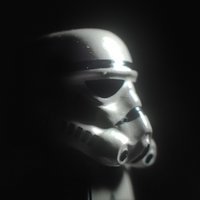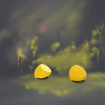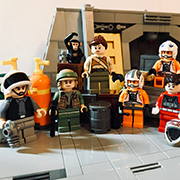Search the Community
Showing results for tags 'Moc'.
Found 5698 results
-
Hello Creator and Disney fans, Mickey Mouse is a legendary American cartoon character co-created in 1928 by Walt Disney and Ub Iwerks. The longtime icon and mascot of The Walt Disney Company, Mickey is an anthropomorphic mouse who typically wears red shorts, large yellow shoes, and white gloves. This is a studless model and everything is brick-built, stickers are not used. I wanted to create a clean model which is as accurate as possible in this scale. It includes many typical details: the yellow shoes, the red pants with white buttons etc.. Maybe the most challenging one was the head with some tricky build techniques. Thanks for visiting, _TLG_ Mickey Mouse - instructions 1 by László Torma, on Flickr Mickey Mouse - instructions 2 by László Torma, on Flickr Mickey Mouse - instructions 3 by László Torma, on Flickr Mickey Mouse - instructions 4 by László Torma, on Flickr Mickey Mouse - instructions 5 by László Torma, on Flickr Mickey Mouse - instructions 6 by László Torma, on Flickr
-
New project is ready! This time something from Ahsoka series: Shin Hati's RP82 Fiend Fighter The build took about 3 weeks, and it was great fun There are 561 pieces here, and one stickers sheet from set 75364 Instructions is available on Rebrickable! https://rebrickable.com/mocs/MOC-168389/EDGE OF BRICKS/shin-hatis-rp82-fiend-fighter/#details more about this MOC on my YouTube channel - Edge of Bricks How do you like it?
-
(Afoland Castle Game. Meronia) King Edric called a runner and gave him an assignment - to go to Kvynn, find Gerard there and give him a letter. The messenger soon reached Kvynn and began asking where he could find Gerard. Naturally, every local knew where Gerard lived, but they could not deny themselves the pleasure of chasing the messenger through the village. Running from house to house, he still managed to find the right one and convey the message.
-
(Afoland Castle Game. Meronia) For a couple of weeks, King Edric had not seen his archmage, Odrimorn. He decided to visit him in the tower and find out what caused his absence. Entering the wizard's room, the king found Odrimorn, who was fumbling in the notes and muttering something. He kept talking about something inevitable, not paying attention to the king. Edric went up to him, touched him by the shoulders and asked why his old friend was so worried. Odrimorn came to his senses and told the king about his fears. All these days he has been haunted by disturbing dreams in which the lands of Meronia are in danger. Unfortunately, the source of the threat is not visible and there are no leads. Various spells and ancient scrolls also did not help shed light on the threat. One thing is clear - these are not just dreams, but something really is coming. We need to prepare... At the end, Odrimorn added: “You know who we need!
-
Hello. I have wanted to make this ship for ages. I initially wanted to make it in midi-scale like all the others that I have shared here so far, but i quickly realized that in order to get the right shapes and curves to this ship I needed to go bigger. So I cannot call this a midi-scale build, but its not UCS scale either, so not to sure what to call the scale. I think it is close in size to the playset LEGO made, perhaps a bit bigger. This ship has been a big challenge, all the curves and subtle angles have been really difficult to get right, but I am quite happy with how has turned out. well its not quite finished yet, it is still work in progress. Thank you for your time!
-
On the desert outskirts of the city where Johnny Thunder lives, there is an old airstrip where Johnny's old friend Harry Cane lives. In his little rundown hangar, the ace pilot maintains his biplane and prepares for the gang's next adventure. The old tin roof has patches of rust on it. The doors can be opened and closed as seen in this animation. On one side of the hangar there is a pile of crates, Harry's motorcycle, and a palm tree. On the other side of the hangar there is an old power generator. The steam powered generator chugs along, providing electricity to the building. Let's take a closer look inside the hangar. The roof can easily be removed to access the interior. This is where Harry's office desk is located. It is cluttered with a radio, maps, bills, booze, and navigation equipment. Next to it is a filing cabinet with a fan and a little easter egg. There's also a pile of cargo crates with adventuring gear, a brass fire extinguisher (the old kind which has a little rubber hose dangling from the top and which you simply tilt upside down to use), and a wall telephone. On this side there is a pinboard with a picture of Harry's friends Johnny Thunder and Dr. Kilroy, and various maps, including ones from the 2 previous adventures that Harry accompanied Johnny on. There is also Harry's workbench and tanks of oil and gas. Here is a closer look at Harry's biplane which he used during the war. The rudder can be adjusted. A small car that Harry uses to get to and from the hangar. It is designed in the style of the little impulse sets and polybags that were common for the Adventurers theme. It has a small baggage area in the back and the classic license plate with his initials. I hope you like this entry. I will leave you with a photo of Harry in front of his plane.
- 14 replies
-
- moc
- adventurers
-
(and 3 more)
Tagged with:
-
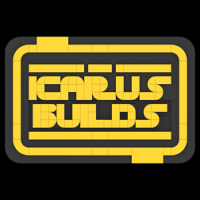
[MOC] Minifig Scale Clone Wars "The Twilight" G9 Rigger Freighter
IcarusBuilds posted a topic in LEGO Star Wars
I've been working on this build since '7680 The Twilight' set came out in 2008. It started out as just modding the set to give it some interior, and slowly evolved with the continuous advances to LDD. Building this was the driving force behind designing my minifig scaled Delta-7, because I wanted to ensure that it would fit inside like in the show. I've gone through countless revisions to my design, even as far as starting from scratch at least 3 times. With every redesign came more research and I learned more and more about the design of this ship. I learned about a lot of things that never made it into the show. Things like that this ship actually has 3 levels to it, and that it uses an elevator to get between them. That they used 2 distinct 3D models of the ship and would switch between them during episodes, etc. It has been a long journey, but I'm finally happy enough with my design to share it. So into the details; Currently the ship sits at a total of 11,259pcs, measuring in at 102 studs (81.6cm) long by 132 studs (105.6cm) wide, by 37 studs (29.6cm) height (landed) or 84 studs (67.2cm) height (both outriggers extended). In other words, this thing is pretty big, still not as big as the Ghost, but it is the same length as the UCS Millenium Falcon. While I did find images and video of the majority of the interior I sacrificed a few of the unseen rooms in lieu of having more structure to hold the whole thing together. I did however keep all of the main areas, this includes the cockpit, cargo hold, connecting hallway and the boarding area. Comparing my build to the official Lego set. Here is a comparison between my Twilight, the UCS Millenium Falcon and my Ghost. As well as some comparisons with some of the official images that used to be on StarWars.com, I couldn't get the angles exactly right, but they're close enough to compare. And as a final note, I am currently in the process of building this monster, I have been slowly gathering pieces for the last few years, I have about 80% of the total pieces required, though I'm sure I'll have to make some modifications as I go. I will be posting updates as I go, but for now, here are my bins of parts, please forgive the unsorted disaster that they are currently in. -
Hi everyone, this is my first post here :) Below is an 8-wide Le Mans race car, which is able to fit a minifigure with helmet in the cockpit. Hope you guys like it ! As I need more funds for my future mocs, this LDD file is now available for sale :) Regards, KMP www.facebook.com/kmpmocs
-
I based this vintage dump truck MOC off the Moving Truck GWP (set 40536) from last year. I made the cab 6 wide and added a new back half. Two each of these brackets are missing from the LDD file: 36841 in black is needed for the front bumper 36840 in yellow is needed for the headlights The rear of the dump truck with the bed lowered. The MOC seats two figures, while the cab doors open and the bed raises to dump the load. Free LDD file available at Bricksafe. Thoughts?
-

[WIP] 5th Gen Toyota 4Runner
damian_kane_iv posted a topic in LEGO Technic, Mindstorms, Model Team and Scale Modeling
I'm a huge fan of the olive green from 42110 and I've been thinking of how to best use the olive green elements from that set. My initial goal was to design a model with working V6, 4-speed sequential gearbox, and AWD. The project has evolved to include part time AWD, central and rear diff locks and an implementation of Toyota's Kinetic Dynamic Suspension System, which modulates anti-roll bar stiffness. I'm working on the second version now. New Update 01/08/2023: My 4Runner model is coming together and approaching complete. Most changes so far are aesthetic, and I have re-designed parts of the body and filled in major gaps. I still need to add seats, steering, gear controls, mirrors, and a rood rack though. I also want to try making this model with alternate colors eventually, and to paint the dark green pieces olive to complete the look. The final model will have a 4 or 5-speed gearbox, fake engine, part-time 4WD, center differential lock, and rear differential lock. I'm also planning to make an RC version with a different gearbox: Brand new front end and headlights I've worked hard on filling gaps head-on 4 NewUpdate 2/19/23: I've been spending a lot of time re-designing my 4Runner moc from the ground up. Work/school has kept me really busy but I've been able to make some progress here and there. My version 2 of the 4Runner has a number of improvements compared to the first version. Overall it is a much more sturdy and functional model compared to the previous design. Playability is way better and the roof feels very sturdy: New suspension is much much better than before. I plan to add pneumatics to front and read for shock absorption in addition to the coilovers that are already present: I'm lot lot happier with the rear axle now. I've finally made a rear axle that has 4 links in a way that I like. I will add the 5th link/panhard rod later. I still haven't found a way to add in the rear diff lock while also creating an axle that is satisfyingly durable with all 5 links. That is a major to-do right now... As a result of the new setup, suspension travel is much greater and satisfyingly responsive: The interior Is much more roomy/spacious now too. I will add seats at the end when I'm satisfied with all of the functions: Finally, I've looked at a lot of other builders including Kevin Moo for inspiration when designing non-right angles. I've used a lot of triangles here to get a design that is compact and strong at the same time: The new chassis has vastly improved rigidity and implements the 4-speed gearbox with a much smaller footprint: Top: Side: Here is a shot of the first version model: The Chassis was originally inspired by filsawgood's Toyota JS as I used it as a test mule for the live axle design: https://filsawgoodltc.blogspot.com/p/lego-suzuki-jimny-sierra-building.html, but it has since evolved -
Prince John Sits inside his lonely castle with everything he could possibly want. Money, Power, Land, Loyal Servants. But he is unsatisfied, craving only the death of the bandit Robin Hood. Meanwhile Robin Hood is enjoying a party with all his friends. He is an outlaw who owns nothing but the clothes on his back and his trusty bow. He gives away all the money he ever gets. And today he is happy, dancing with his one true love Maid Marion while all his friends dance play and sing around him. My goodness this took forever to edit. Stupid Leaves. Built for the "Light & Shadow" Category for the 2023 Summer Joust. Hopefully this is the right forum, it could also belong in licensed themes, but I figured it was a better fit here. I did enter it in the Summer Joust after all.
- 10 replies
-
- moc
- robin hood
-
(and 7 more)
Tagged with:
-
"Commander Cody, prepare the gunships for ground assault!" Let's give the Midi-Scale treatment to another timeless ship: the LAAT Gunship or Republic Gunship from The Clone Wars. Being a fan of the sleek and flush Clone Wars era design, I thought this variant deserved more attention, especially in Midi-Scale. This Midi LAAT/i consists of 1,015 pieces, measures only 22cm (without guns), and is accurately Microfig-scaled. It features a fully SNOT look, openable front doors, and a removable stand that can be tilted to taste. Design-wise, this ship was full of challenges, with lots of subtle angles and curved surfaces everywhere. Shaping the front section wasn't an easy task at this scale, as well as adding that crucial touch of lime green without any stickers. All of this resulted in a pretty intricate structure, especially for the front section. The angled rear section of the body features other details such as missile belts, exhaust slats and tail cannon. The underside of the ship is also fully SNOT-built. Initially, all four doors could be opened, but I chose to remove the less useful rear door mechanism for a smoother, easier building process. ► Instructions for the LAAT are available at BrickVault! More pictures on my Flickr page.
- 8 replies
-
- midiscale
- midi-scale
- (and 13 more)
-
Just began another baja/ trophy-truck project, the other 2 (or 3) being ”canceled”. I managed to put 2x L motors and 1x servo motor, both Power Functions; it also has positive caster-angle, independent suspension in front and solid axle suspension on the rear, (at least) semi-detachable body and the headlights can be be lit (there are 4 pin-holes for installing lights). Heavily modified version of this
- 81 replies
-
- power functions
- moc
-
(and 3 more)
Tagged with:
-
It's finally finished! Luas full length Luas is the tram here in Dublin, and I've been wanting to build one for a long time. I started about a year ago, when I got the general concept for the cars figured out, but then abandoned it for a while. Sometimes the inspiration just isn't there... Anyway, over the past few weeks I figured out the cabin, the connections between the sections, improved the doors, which required a different way of doing the roof.... One thing I decided right at the start is that I wanted to do the micro-stripe yellow above the purple. The first idea was to use brackets (1x2/2x2 and 1x2/2x4) and you can still see those in the middle section. Luas middle section However for the outer sections I had to change the concept, as the plate part of the brackets got in the way of the sideways built doors. I ended up using flags, but getting enough of them in yellow and in the old mold (the clip is slightly different in the newer ones, and unfortunately Bricklink doesn't differentiate) was not easy. It's powered by a 9V train motor in the middle and it can manage the tight curves: Luas inside curve It does have a bit of an overhang, so don't park close to the tracks ;-) Figuring out the shape of the 'dressed up' bogies was not easy, despite the simplicity of the final design. Getting the bodie shape around them was even harder. The connectors between sections were another headache that's gone through umpteen different designs. In reality they're an accordion-type structure which is impossible in Lego. So I needed something that would keep the sections close on the straights, and would allow the tram to go around standard curves without showing a big ugly gap. For transport it also had to be easy to take the sections apart and for reliable running the connection has to have some flex when the track isn't perfectly level. I managed to do all of that:
-
Hi everyone, I present my latest MOC: this small cargo shed! It's packed with lots of details, which you can view below. Thanks for watching!
-

MOCs versus sets
PlopiNinetySix posted a topic in LEGO Technic, Mindstorms, Model Team and Scale Modeling
Hey everyone, I got this kinda question floating around my head now and felt like it could have a discussion here. Which Technic sets, in your opinion/s, are the closet to similar MOC counterparts, or even better? Basically, which LT sets are so good/well-designed/excellent/awesome [and other superlatives alike], that these could potentially reach the standard/s of a MOC? *I have to note here that all MOCs (of some vehicle/machine) vary in standards, designs and functions, so this question might be a bit ambiguous Some of mine would be 42145, 42114, 42043. -
Hello to the community. The last weeks, I had finally a bit more time for LEGO, so I started a new small digital project: (digital) modern redesign of the classic LEGO Set 4554 Central Station (also known as Metro Station) from the LEGO Trains Theme from 1991. These have been my first steps in the Lego Train Theme, maybe you like the result. ;-) Picture 1: 4554 Central Station Revisited Picture 2: 4554 Central Station Revisited I also created some building instructions for the train station. You can download them (PDF File, 125 pages, for free, no registration) under the below URL: http://afol.lu/afol52/filebase/index.php?file/55-lego-4554-central-station-revisited/ Ok, this is now a bit offtopic, but may I ask you however, as a sort of recompensation, to vote for my LEGO Ideas Project Queen Elizabeth II and share my project idea in social media. You can vote for my project here: https://bit.ly/legoqueenelizabeth . I would really appreciate. Happy Building, stay safe and keep healthy. :-)
-
Hello Lamborghini and Speed Champions fans, The Lamborghini Diablo is a high-performance mid-engine sports car built by Italian automobile manufacturer Lamborghini between 1990 and 2001. It is the first production Lamborghini capable of attaining a top speed in excess of 320 kilometres per hour (200 mph). Building instructions are available on the following links: It is a studless build in the new, 8 studs wide Speed Champions style. I wanted to create a clean model which is as accurate as possible in this small scale. I prefer the brick built solutions to keep the flexibility of the used parts in further builds, and therefore only one Lamborghini logo sticker and a standard vehicle registration plate sticker are used. My intent was to keep the width-length-height ratio of the real car and this size makes it possible. The model contains lots of details: for example the emblematic taillights, the side air intakes, the side view mirrors and rear details with the double exhausts etc... Maybe the most challenging one was the hood tilt and some half stud offsets in the inside structure. I tried to fill every unnecessary gaps and therefore some tricky build techniques are used. The model has space for two minifigures with helmets or small hairs. Thanks for visiting, _TLG_ Lamborghini Diablo - Instructions 1 by László Torma, on Flickr Lamborghini Diablo - Instructions 2 by László Torma, on Flickr Lamborghini Diablo - Instructions 3 by László Torma, on Flickr Lamborghini Diablo - Instructions 4 by László Torma, on Flickr Lamborghini Diablo - Instructions 5 by László Torma, on Flickr Lamborghini Diablo - Instructions 6 by László Torma, on Flickr Lamborghini Diablo - Instructions 7 by László Torma, on Flickr
-
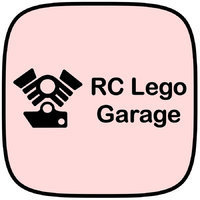
Eagle V2 an RC Trophy Truck [MOC]
Daniel-99 posted a topic in LEGO Technic, Mindstorms, Model Team and Scale Modeling
Hello, EuroBrickers! I am pleased to present to you the second version of my RC Lego Trophy Truck EAGLE. To be more specific, this is the third deep modification of the second chassis. Not surprising, as I've been working on this project for over three months now. For a better understanding of this topic it is worth reading about the first version. A better quality photos could be found on my BrickSafe. And a video: First looks: Features Independed suspension at the front with positive caster angle. 4-link solid axle suspension at the rear with anti-roll bar RC shocks (80 mm at the front and 110 mm at the rear) Brushless motor A2212 1200 kv for propulsion, Geek Servo for steering, 1500 mAh 3S Li-Po for power Strong and efficient transmission with metal U-joints and metal bearings. 95 mm RC wheels Light-weight bodywork Main goals "It's never a good idea to stop if you have something to improve." With these thoughts I was preparing a post about my Eagle a month ago. Here's a list of things I wanted to improve: Weight distribution: the heavy electronic components located in the cab loaded the front suspension more than the rear suspension. Rear axle geometry: due to triangulation on the rear axle, the driveshaft and lower suspension arms were located very high off the bottom of the truck, which limited the maximum compression angle of the rear suspension, and the entire chassis was not set to the horizon. Rear suspension setup: a true trophy truck requires a suspension with progressive stiffness. Front axle: steering was very sensitive, rather unusual front triangle shape and tilted lower suspension arms. Overall bulkiness of the chassis. Electronics The Eagle V2 utilizes the same electronic components as the Eagle V1. The story of my choice of such components is given in the post about Eagle V1. Therefore, I will be brief here. Motor: A2212 1200 kv Battery: 3S Li-Po 65C (30C is more than enough) 1500 mAh Controller: 2-3S 35A Transmitter: FlySky FS-GT5 Pros: Brushless motors last longer than brushed motors. High speed and torque in a compact size (about 3 BM in an XL motor) Radio control (best for fast RC cars) Cheap components (compared to Lego electronic components) available at local RC stores. External Li-Po battery allows for different layouts and unlimited power flow. Cons: Requires advanced techniques to build strong transmissions (requires lubrication) Otherwise can easily damage plastic parts. Not an easy decision for purists. Difficult to share instructions with others. Have to take care of tangling wires (same goes for large Lego-is designs). Non-universal solution, suitable mainly for RC Lego machines without a list of additional features. Frame & layout The Eagle V2 has a new "tube frame" (or chassis). This is why I decided not to call it a modification of my Eagle. Let's take a look at it from front to back. All important terms in this section are marked with bold text. In addition, this terms are highlighted on pictures. The front triangle uses the same "almost right" triangle with 14,15 and 6 stud lengths as the Eagle V1. The lower tube of the front triangle is made of two flip-flop beams that have been stacked together. This solution provides a sufficient level of stiffness and resistance to torsion. In addition, I was able to bring the suspension arm mounting points as close to the center as possible. The lower tube of the front triangle is adjacent to the flat bottom made of panels. The upper tubes of the front triangle intersect with the front wall. Further they pass into the side tubes of the cockpit. These tubes are made with flip-flop beams, which allowed me to secure them in place with a 15L front cross-brace (the Eagle V1 cockpit was 2 studs thinner). It's worth noting that the GeekServo motor squeezed perfectly between the lower front triangle tube and the cross-brace of the front wall. Thus, it practically reinforces the front triangle. The cockpit ends at the rear wall, which is reinforced by a rear triangle and structure around the transfer case housing. The side tubes pass into the rear H-tubes (horizontal). At the same time, the rectangular rear triangle is mirrored to form another rectangular triangle at the very back of the truck. The cross-brace on the rear wall is made using L-beams and 3D printed motor housing. Now let me describe the layout of the electronic components. Using a custom transfer case housing, I was able to move the brushless motor out of the cab. It is now located directly behind the rear wall. More importantly, I was able to move the Li-Po battery out of the cab. It is now located above the motor. It is true that this solution increases the center of gravity, but on the other hand it provides excellent weight distribution, which is very important for a trophy truck. The controller is located in the cab next to the driver's seat. Both battery and controller have no pin-holes, but I was able to fix them in place quite greatly. To load the rear axle even further, I added the spare wheel. Bodywork My main goals with bodywork of Eagle V2 were the following: keep it light keep the original shapes of Eagle V1 improve the proportions As a result I made the whole truck one stud longer and two studs wider than the first version. Now cockpit is wide enough to fit the driver`s seat. Also I changed the bonnet and the front grill. Finally I changed the very back of the truck to make it closer to real prototypes. I have to add, that not only the bodywork make the car look good. More importantly to keep the proportions in the chassis. The authentic look of the Eagle V2 is achieved with the proper settings of the suspension. Transmission I'd like to make a 3D model of my truck and show you a nice rendering of the drivetrain, like some great technical builders do. However, the Eagle V2 has a lot of custom parts and a bunch of "illegal" techniques like "almost rectangular" triangles. So I will just mark out the transmission components: Brushless motor with custom housing with planetary gear inside (1:4 gear ratio) Central transfer case with 28:20 gear ratio Rear differential with 12:28 gear ratio The transmission is built on carbon fiber axles and metal U-joints. It is separated from the frame by metal bearings. Metal bearings are used in the center transfer case, in the 5x7 frame that holds the differential, and in all the wheel hubs. I also lubed the planetary gear inside the engine case. Suspension geometry As I've said before, trophy trucks are all about suspension. So the main reason I did a V2 of my Eagle is to try and improve the suspension (both front and rear). Front suspension: Truth be told, not all custom parts turn out to be universal. On the contrary, the idea of efficiency in certain places and the idea of universality are not compatible at all. The Eagle V1 front wheel hubs are a prime example of this principle. They were originally designed for IFS street cars with smaller wheels. Therefore the basic ideas are present in their geometry: An inverted ball joint for the lower suspension arm (which is great in general). Combined with the tilted front suspension, they looked nothing like real trucks. The steering arms were 0.5 studs long, which resulted in very sensitive steering. I also didn't really like the 8 stud length suspension arms, which required custom of steering links to work properly. So I designed a new front suspension system that includes: 9 stud length suspension arms. New hubs (originally designed for live-axles) with 1 stud length steering arms. Thus hub does not use the ball joints! The new design is a deep modification of the Falcon trophy truck front suspension, which has proven to be reliable. In the V1, I used 8-studs suspension arms to fit within a certain chassis width and maintain a strong lower tube of the front triangle. However, by using stacked flip-flop beams, I was able to keep it 1 stud wide without losing stiffness. Rear suspension: It won't surprise you that the Eagle V2 has a new rear suspension. Here's a list of the changes: A new rear axle has been designed (again with a different set of custom hubs). It's more compact than the one the V1 had. The upper triangle of the suspension arms has been inverted (to match the real-world examples). New lower arms have been build. Now the live-axle was given the necessary degree of freedom. The attachment points for the suspension arms were lowered by two studs. This modification was possible due to the changes in the drivetrain described above. The anti-roll bar has been redesigned to match real prototypes. It resists to the twisting effect of the rear axle that appear in the acceleration. Shocks "Once a perfect suspension geometry is achieved, one may look for a proper set of shocks springs" The best springs Lego ever made are the hard 9.5 L springs, because they have a good amount of travel and responsiveness. For example, the 9.5 L soft shocks are not as good because the spring force has a hard time overcoming internal friction. On contrary, the 7L hard shocks have little travel and not enough stiffness to work properly with the hard springs. So I used 9.5L hard springs in the Eagle V1 and early versions of the second chassis. I tried to build a progressive rear suspension using Lego springs, but was not successful. The resulting design was either too unreliable or too bulky. I guess I lacked luck and skill, but I couldn't build a suspension that was both soft and shock resistant. It was either too stiff to absorb big bumps or too soft. So I decided to use RC shock absorbers to properly address this issue. RC shock absorbers have different springs that allow you to adjust SAG and progression without having to move the shock absorber mounting point along the suspension arm. I once tried to adapt RC shock absorbers to Lego, but couldn't find a suitable way to attach them to the Lego pins. Fortunately, a working solution was offered by Ryokeen in his Generic Brushless Trophy Truck. I again had to modify the chassis to fit 1:10 scale RC shock absorbers. Front suspension has 80 mm shocks with 2.5 studs travel. I mounted it behind the suspension arms as it is done it real Trophy Trucks and many RC scale models. There was a way to place it through the upper A-arm, but such solution required 4L liftarms. In addition it had not freedom in the choice of mounting points. Rear suspension uses 110 mm shocks with approximately 3 studs of travel. Additionally they have a dual spring setup, which give the desirable progressive hardness to the rear suspension. Again, I tried to mount rear shocks in the same way it is done in real Trophy Trucks. Developers diary. 3-7 Sep An Eagle V1 was finished. The driving tests started. Front wheel hubs are the same as in Hornet 4x4 Buggy. 11-15 Sep The new front triangle has been built. Now truck has a tilted lower tube and positive caster. The differential has been changed from yellow to red one. 17 Oct I stated developing a new chassis with a different set of ideas behind. (mostly with the triangulation in the rear axle removed and central transfer case added). 24 Oct First prototype of the new chassis has been built. In addition to the redesigned rear axle, I made a new front axle with a shock coming through the upper A-pillar. 27 Oct I started building a bodywork for a new chassis. 1 Nov The first modification of the second version of Eagle has been finished. I started the driving tests. The rear suspension has a new idea if mixing anti-roll bar with additional shocks to achieve progressive suspension hardness.... that was a total madness... 8 Nov The whole chassis has been widened by 2 studs for better proportions. 14 Nov A new rear suspension ideas has been applied. The back of the Truck has been changed. Now the rear suspension has two sets of hard 9.5L springs on each side. Progressive stiffness... Bulky realisation. 25-28 Nov RC shocks has been added. For that reason both front and triangles has been redesigned. -
I'm happy to be able to share my latest medieval MOC, Dragon Fortress Pagoda. The colour scheme draws inspiration from 7419: Dragon Fortress, while the structure is based off Ayrlego's Lotii Pagoda. I have built a similar structured Pagoda in the past but was keen to try a new colour scheme, tiled roofs, and add a little flora. Dragon Fortress Pagoda 3 by Samuel Sheppard, on Flickr Dragon Fortress Pagoda 2 by Samuel Sheppard, on Flickr Dragon Fortress Pagoda 1 by Samuel Sheppard, on Flickr Thanks for looking!
-
Hi! Today I start my new project: Winter in the Raven's Wharf This will be my biggest MOC to date and there are quite a few topics to cover I plan to build a medieval port somewhere in the far north. I did surveys on YouTube and Instagram, I asked what season to choose... ...Winter won! The project will consist of several parts, the whole thing will be divided into several baseplates. The size of 60x150 studs is planned. On the waterfront, I will want to build a lot of buildings for residents, but also military ones. The main attraction, however, will be the large ship I'm already building There are several inspirations, I will definitely turn on the Witcher 3 game more than once to explore Novigrad and look for interesting ideas. The main ship will have about 1500 parts and I will definitely make a PDF instructions for it. I've already built a small boat for a fisherman, I'll probably build more of these. I'm going to need a lot of parts, especially for building water. Since I'm building winter, I'll want to use the new animals from the City Arctic series - I'll add some seals, but I'm tempted to add a killer whale as well. You can learn more about this project from my video, link below. I will be glad if you write what you think about this project, but also write your ideas what I can build here :) In the next episode I will definitely want to show the finished ship, I will have to make sails and instructions.
-
After a year's break from Star Wars, I decided to improve one thing in my collection. I already had one MOC/MOD for X-Wing, strongly based on the 75218 set, but for some time there were a few things that bothered me about it. It turned out that the rubber bands had lost their properties and the mechanism was malfunctioning. Plus I wanted something much better and here it is my new Luke Skywalker's X-Wing Fighter The build took about 3 weeks, I had most of the parts so I only needed one order on Bricklink. There are 985 pieces here, quite a lot. The mechanism works on the same principle as in the 75301 set My X-Wing has retractable landing gears and a new type of display stand. Instructions is available on Rebrickable! more about this MOC on my YouTube channel - Edge of Bricks
-
Discovering the Battle of Hoth on screen is one of those childhood moments I'll always remember. So my first ever walker MOC had to be the AT-AT from Episode V: The Empire Strikes Back. And for such an iconic scene, making a diorama-style build was mandatory. At only 19cm (7,4") high, this Midi-Scale AT-AT consists of 924 pieces (1,317 in total with the diorama base & T-47), and is accurately Nanofig-scaled. It features a movable head and fully articulated legs, allowing many different poses. Working at such a compact scale, capturing fine surface detail and smooth, gapless angles for the body required a great deal of unique techniques. My main goal was to make the model feel deceivingly heavy and massive despite its small size, and of course achieve that prop / toy vibe I'm so fond of. The most challenging parts of the AT-AT were definitely the head and legs: the head for its subtle angles and challenging shape, and the legs for proportions, joints, feet, and very slight width differences as you go towards the bottom. Nanofigs (or trophy figs) scale perfectly to both the AT-AT and T-47, which also scale accurately to each other. The diorama base allows the AT-AT feet to be connected in various positions, and can accommodate two flying T-47s. This 358-piece base is optional and comes in a separate parts list, for builders who prefer displaying the model solely (picture 7 in the Flickr album). Parts list also include a string piece that can be easily added to reproduce the harpoon scene (picture 5 in the Flickr album). ► Instructions for the AT-AT are available at BrickVault. More pictures on my Flickr page.
-
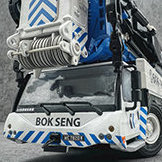
[MOC] Benz-Unimog 4×4 Off-road RV
dls7223685 posted a topic in LEGO Technic, Mindstorms, Model Team and Scale Modeling
Hello everyone, this is the latest work from MTC: Benz-Unimog 4×4 Off-road RV Designed by Muen 1. Function Description ① XL×2:providing power ② Servo×1:steering ③ M×1:2-speed gearbox shift ④ M×3:3 differential locks for front, middle and rear ⑤ SBrick×2 ⑥ Small battery box ×1 ⑦Yellow hard spring ×8 2. Appearance "Modularity" is a design concept that runs through the design of the car from start to finish. From the exterior to the interior, I have modularized all the parts as much as possible, with the obvious benefit that it is very easy to assemble and disassemble, and no longer afraid of transportation. At the same time, each model is clearly positioned before it is designed, which determines the tendencies and trade-offs when designing. The positioning of this car is mainly to do my best to restore the appearance and rich interior of the real car, so this car uses technic parts to build the chassis, and particle parts to build the appearance and interior. The following are photos of the whole car's appearance, and according to the real car's beautiful pictures taken at the same angle, please enjoy. 3. Interior I always think that the interior of an RV is a very important part, so in the process of designing this car, it can be said that the design of the interior took up half of the focus and energy. Another important reason why I personally like RVs is the various storage spaces, which can be a storage space in places you don't expect, so I also built more storage spaces when designing the interior. The following is a detailed introduction to the interior of this car, I hope you can enjoy it. (1)Cab ① Seats The design of the seats uses #99563 to shape the unevenness of the surface, while the base under each seat consists of four #4532 for additional storage space. Behind the front seats are shelf baskets and in-car video for rear passengers to use and provide entertainment during the drive. ② Central Console I divided the center console into two parts, front and rear. For the front center console, there are several storage spaces with three drink holders. At the same time, there is a shift lever, handbrake and a number of function control buttons set up on the side near the main driver. And the side near the passenger side is the air conditioning vents. For the rear center console, a number of storage space and drink placement that must be the regular configuration, front and side air vents and air conditioning adjustment knob. There is a small clock in the middle for the rear passengers to see the time, but also equipped with a blue satellite phone, we all know that the wilderness places or satellite phone more reliable. Here are photos of the combination of the front and rear master consoles (2)Living area The living area is also designed with rich interiors and "modular". There are two main purposes, one is to facilitate the display of the interior, because my first off-road RV work "Conqueror F", in the process of display found that the interior can not be well displayed. the second is to allow the weight of the car to be reduced during the driving process. So the interior of the living area is very easy to remove as a whole. The interior of the rear compartment consists of 9 main parts, let me introduce them one by one below ① Kitchen Due to the limited space, the kitchen is all open, I personally divided it into 3 sections. First is the lower area, which is a variety of storage space for dishes, I also placed a garbage can, specifically for food waste. The second is the middle area, where the cooking is done, the left is the sink, the right is the stove, most RV's kitchen stove is covered, this is no exception. A variety of pots and pans as well as a wealth of spices hanging on the wall, and a range hood directly above the stove. Finally, there is the upper area with a blue microwave oven and two storage spaces. ②Bar I personally like the bar very much, so I also designed a bar in this RV, mainly for making various desserts and beverages during the rest of the day in the car. The lower half of the bar has 2 levels of storage space, mainly for cups and unopened drinks. The upper part is mainly for a small number of commonly used cups and 2 desserts that have just been made, and there is also a beverage machine with 4 different drinks. These 4 drinks are: orange - Fanta; red - Coke; green - Sprite; blue - Mizone. ③ Left side of the entrance door This module consists of three parts. The lower part is a fire extinguisher. In case there is a fire in the process of parking rest or entertainment outside the car, you can get the fire extinguisher nearby at the first time. In the middle is a white fridge, close to the kitchen and bar for easy cooking. The upper part is a small open storage space. ④ Right side of the entrance door This module is also composed of 3 parts, the lower part is a two-layer shoe rack, placed at the door, in and out of the door is convenient to change and put shoes. In the middle is a small storage space, which is mainly used to place umbrellas to prevent rain from touching the wetland board; There are also two hooks for hanging hats. The upper part is the switch box, the whole living area power switch, there is a specific instrument to show the real-time data of the living area electricity. ⑤ Sofa This car is equipped with two large electric sofa, placed opposite, sofa side armrest has adjustment knob and small display screen. Among them, the sofa near the side of the bed, the bottom is installed with a slide rail, moving the sofa, can enter the storage room under the bed. A sliding rail is installed at the bottom of the sofa to facilitate horizontal movement. ⑥ Table There is a table in the middle of the sofa. To expand the limited space, the table can be folded. After the table is folded, flowers can be placed on the table to beautify the interior environment. ⑦ Storage room The living area has 2 large storage units, mainly distributed under the bed. One is the common storage room, mainly placed washing machine, cleaning tools, repair tools and other common items; The other is a hidden storage unit behind the sofa, which can be accessed by moving the sofa and is used for infrequent items such as suitcases. ⑧ Toilet The toilet is equipped with a toilet that can also be used for bathing. There is a hot and cold water sign and a toiletries basket in the corner. ⑨ TV set The TV set is placed above the sofa and facing the bed, so that whether you rest on the sofa or in bed, you can watch TV programs and relax. Finally, a panoramic view of the living area! 4. Some Details (1)Where is the battery box hidden? (2)The living area tank is located below the rear door (3)Where is the spare oil drum hidden? (4)For parking rest and picnic outside the car, there is a foldable table on the back of the door of the living area, and it is equipped with a storage box (5)Because the car chassis is higher, so the left side of the staircase is designed with handrails, when entering the living area, convenient borrowing; There is a clock on the top of the handle, which is mainly convenient to check the time when taking a rest outside the car or having a picnic (6)The shoe rack is by the door (7)A fire extinguisher is placed in the back of the cab. (8)Skylights in the living area can be opened (9)It's 2023, car phone holder must have! Convenient map navigation! Finally! Hope you enjoy it! Thanks for browsing! Benz-Unimog 4×4 Off-road RV From MTC·By Muen·For Gap.Li



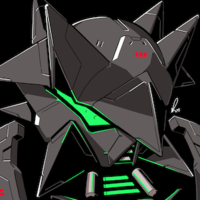
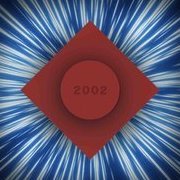
-min(2).thumb.jpg.89062c1a498f0e11e435e64ef3149476.jpg)
